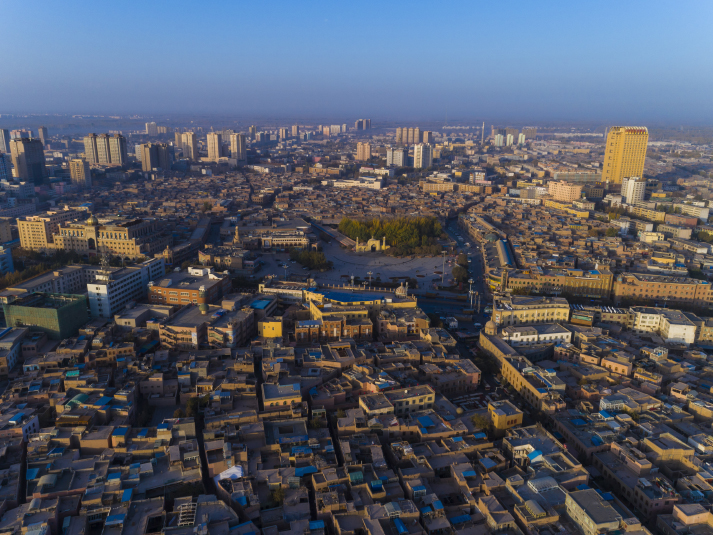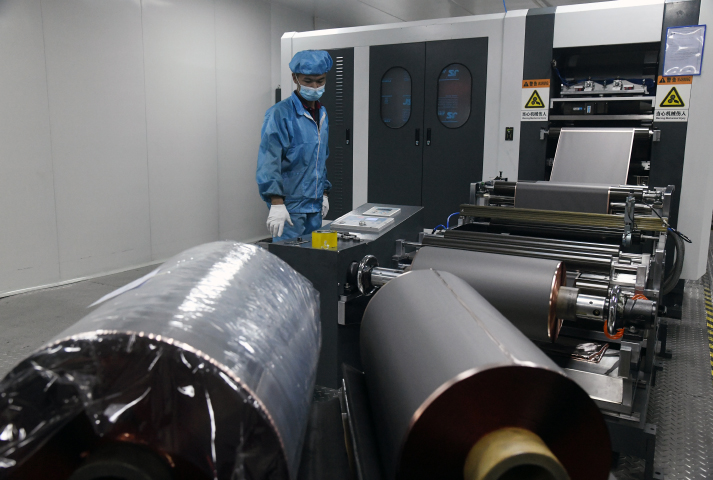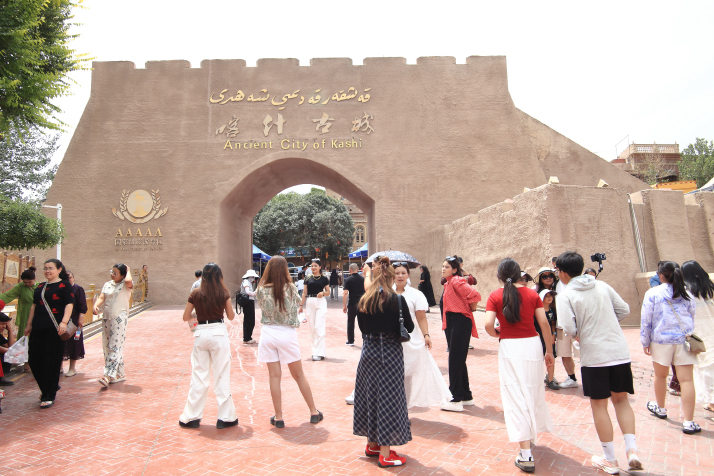| Xinjiang Today |
| Kashi: a thriving business hub | |
|
|
 A bird's-eye view of Kashi City (XINHUA)
Trucks heading to Central Asia with home appliances and textiles. Merchants using mobile video calls to negotiate orders with European clients. Cross-border e-commerce livestreamers working late into the night… These are common sights in Kashi (Kashgar) Prefecture located in southwest Xinjiang.
Kashi, a busy entrepot along the ancient Silk Road, is writing a new chapter in its history as it makes the most of geographical advantages, policy support and an inclusive trade ecosystem. Official data show that in the first half of this year, Kashi's import and export volume reached 64.32 billion yuan ($9 billion), a year-on-year increase of 15.1 percent, a record high. As the China-proposed Belt and Road Initiative boosts connectivity along and beyond the ancient trade routes, Kashi has transformed into a modern Silk Road hub.  Products from Kyrgyzstan on display at a cross-border e-commerce center in Kashi in September 2024 (XINHUA)
A golden corridor
Kashi's geographic advantages can be summed up as "five ports connecting eight nations, one road (Silk Road) linking Europe and Asia." It has five ports of entry (POEs), four by land and one by air. The Hongqilafu (Khunjerab) Pass is an overland route for tourists, businesspeople and goods between China and Pakistan. Kalasu (Karasu) is an international crossing between China and Tajikistan. Tuergate (Torugart) and Yierkeshitan (Irkeshtam) are commercial POEs between China and Kyrgyzstan. Kashi is also home to the first air POE in south Xinjiang. Neighboring eight countries, namely Mongolia, Russia, Kazakhstan, Kyrgyzstan, Tajikistan, Afghanistan, Pakistan and India, the prefecture is a crucial gateway for China's westward opening up. Kashi's open economy has surged forward, with its foreign trade performance standing out. Last year, its foreign trade hit a record 99.44 billion yuan ($13.8 billion), surpassing the 90-billion-yuan ($12 billion) mark for the first time, up 18.8 percent year on year. It accounted for 22.9 percent of Xinjiang's imports and exports and ranked second among all prefectural-level administrative divisions in the autonomous region. The state-level China (Kashi) Cross-Border E-Commerce Comprehensive Pilot Zone, approved in 2022, is the first of its kind in Xinjiang. It focuses on building cross-border e-commerce clusters serving Central Asia, South Asia and West Asia, and has become a major engine for Xinjiang's foreign trade growth.  Livestreamers promote freeze-dried melon in Zepu County, Kashi Prefecture, on July 7 (VCG)
The China-Kyrgyzstan-Uzbekistan Railway, a flagship project of the Belt and Road Initiative, will open a shortcut between China and Europe, reducing the distance by 900 km and cutting the freight transportation time by seven to eight days. The railway will start in Kashi, cross the Tuergate port into Kyrgyzstan, proceed westward through the Kyrgyz border city of Jalalabad and reach the eastern Uzbek city of Andijan. The project's commencement ceremony was held in Kyrgyzstan in December 2024 and the construction period is expected to be six years. This railway will bring new trade opportunities to the regions along the route and as its starting point, Kashi stands to gain immensely. The planned Kashi International Transportation Hub will be a multimodal logistics center consisting of railway, highway and air ports and outreach zones of border land ports. E-commerce giant JD.com opened an intelligent logistics facility in Kashi in April, reducing the average delivery time of online orders by two days, thanks to its automated sorting systems. International orders can be delivered in three days at the quickest.  A lithium-ion battery company in the Kashi Economic Development Zone in September 2023 (VCG)
An enviable tax break In terms of policy support, a corporate income tax break, effective from January 1, 2021 to December 31, 2030, has reduced the operational burden on enterprises, providing incentive for their sustainable and sound development. According to this policy, eligible newly established enterprises in the Kashi Economic Development Zone will enjoy a five-year corporate income tax exemption starting from the tax year in which they obtain their first operating income. From the sixth to the 10th year, they will enjoy a 50-percent income tax reduction. In the first half of this year, the number of business entities in Kashi crossed 406,000, an increase of 6.1 percent compared with the same period last year. "Kashi has great room for development in e-commerce infrastructure construction, which is also a new opportunity for individuals and enterprises in the industry," Zhou Jihao, Deputy General Manager of JD.com's Kashi intelligent logistics facility, told newspaper China City News. The average age of Zhou's team members is 28 years and they have mostly studied overseas. Zhou said more and more people like them are choosing Kashi to develop their careers, which also reflects the city's improved attractiveness and inclusiveness. Kashi Prefecture Quick Facts Area: 162,000 square km Population: Approximately 4 million GDP (2024): 162.6 billion yuan ($22.6 billion) Administrative divisions: Kashi City, Shufu County, Shule County, Yingjisha (Yengisar) County, Yuepuhu (Yopurga) County, Jiashi (Payzawat) County, Shache (Yarkant) County, Zepu (Poskam) County, Yecheng (Kargilik) County, Maigaiti (Markit) County, Bachu (Maralwexi) County and Tashikuergan (Taxkorgan or Tashkurgan) Tajik Autonomous County (Source: Kashi Prefecture Administrative Office)  The ancient city of Kashi on July 16 (VCG)
The Ancient City of Kashi Walking into the ancient city of Kashi is like entering a magic world with a long history and diverse cultures. It feels ancient, modern, peaceful, bustling, colorful, open and inclusive... Everyone who comes to Kashi has their own feelings about it. Located in southwest Xinjiang, the ancient city was one of the important stops on the ancient Silk Road and a confluence of Eastern and Western cultures. It has one of the largest surviving collections of earthen buildings in the world. In 1986, Kashi City, where the ancient city is located, made the national list of cities with historical and cultural significance. In 2010, a project was launched to renovate the ancient city, involving a population of about 220,000. More than 49,000 traditional dwellings with historical and cultural value have been renovated and reinforced while retaining the original spatial pattern. The ancient city, once reduced to a sprawling shantytown, has become the first national 5A-level (top-level) scenic spot in Xinjiang. The ancient city accumulated rich heritage for thousands of years. Walking in its alleyways, you can find that much of the intangible cultural heritage has been developed into cultural and creative products, which are boosting the tourism industry. With the integration of tradition and modernity, Kashi today showcases a vibrant, harmonious and inclusive cultural landscape. In the first half of this year, Kashi Prefecture, which administers Kashi City, received nearly 28 million tourist visits, a year-on-year increase of 21 percent. Tourism revenue crossed 24 billion yuan ($3.4 billion), a year-on-year increase of 28 percent. (Source: English.ts.cn) Comments to yanwei@cicgamericas.com |
|
||||||||||||||||||||||||||||
|